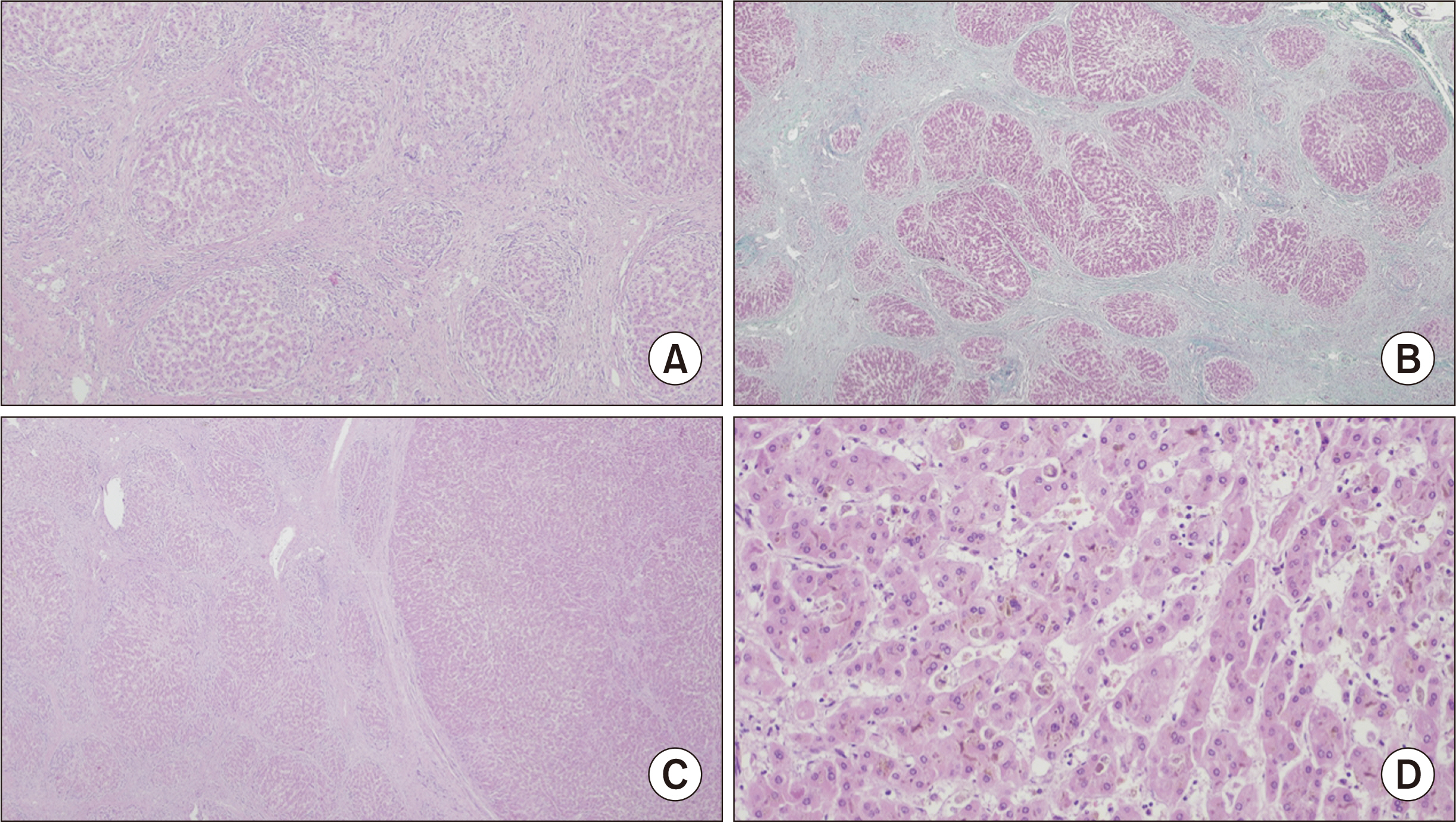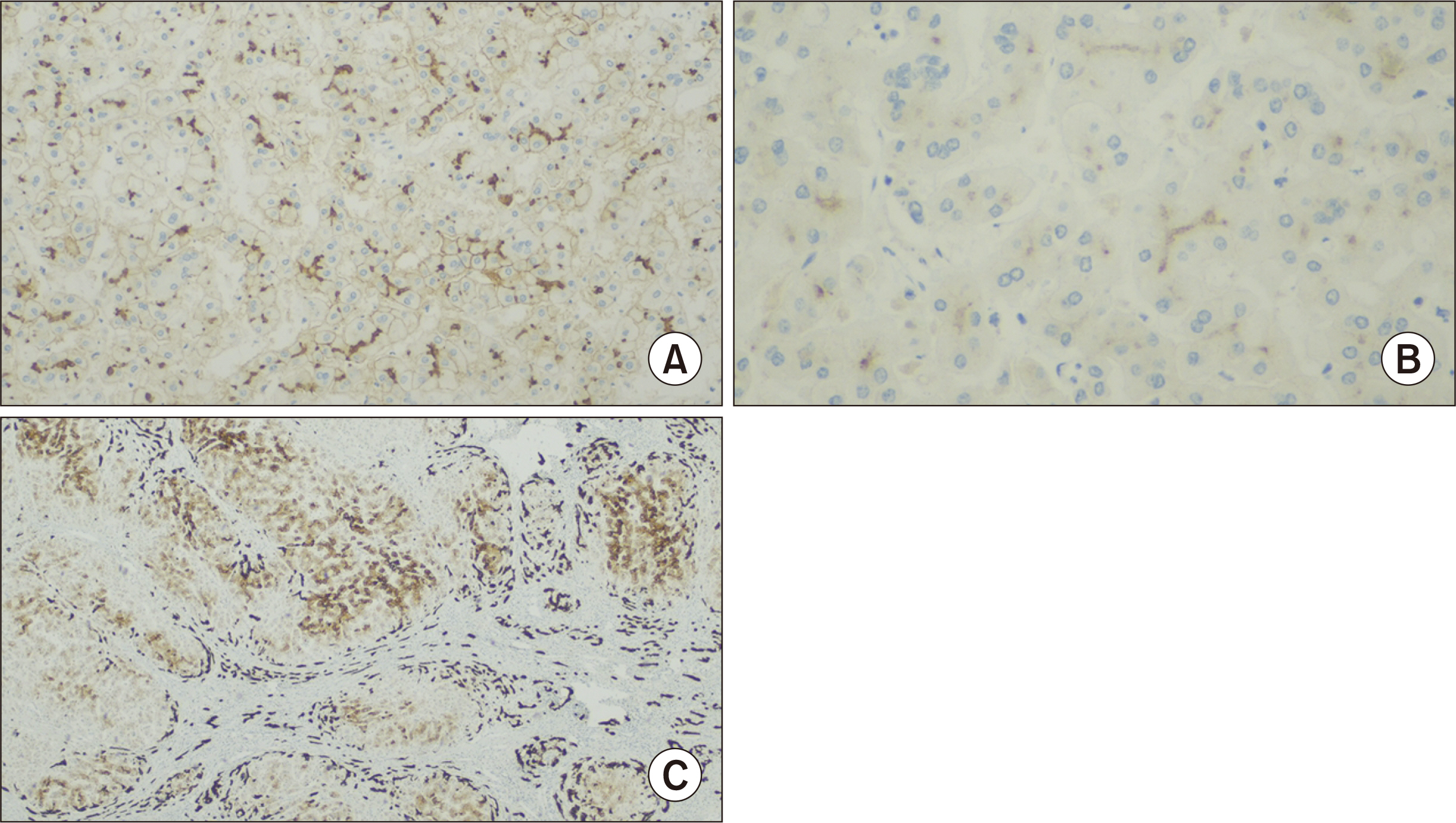Clin Transplant Res.
2024 Sep;38(3):241-245. 10.4285/ctr.24.0016.
Hepatocellular carcinoma associated with progressive intrahepatic familial cholestasis type 2: a case report
- Affiliations
-
- 1Faculty of Medicine, University of Coimbra (FMUC), Coimbra, Portugal
- 2Department of Pathology, Unidade Local de Saúde de Coimbra, Coimbra, Portugal
- 3Unidade de Hepatologia e Transplantação Hepática Pediátrica, Unidade Local de Saúde de Coimbra, Coimbra, Portugal
- 4Coimbra Institute for Clinical and Biomedical Research (iCBR), Coimbra, Portugal
- 5Centro de Investigação em Meio Ambiente, Genética e Oncobiologia (CIMAGO), Coimbra, Portugal
- 6Department of Surgery, Unidade Local de Saúde de Coimbra, Coimbra, Portugal
- KMID: 2559815
- DOI: http://doi.org/10.4285/ctr.24.0016
Abstract
- Progressive familial intrahepatic cholestasis type 2 (PFIC2) is an autosomal recessive disorder typically presenting in infancy with cholestasis and rapidly progressing to cirrhosis. PFIC has been associated with an elevated risk of hepatocellular carcinoma (HCC), a neoplasm that is uncommon in children. PFIC type 4 has the strongest link to this type of cancer, although a few cases have also been connected to PFIC2. Herein, we report the case of a 2-year-old boy who underwent liver transplantation due to PFIC2. Histological examination showed cirrhosis and four small HCCs. Over a 20-year period following the transplantation, there was no recurrence of the disease or HCC. Although rare, HCC development can occur in PFIC and may complicate the prognosis. Liver transplantation offers a potential cure for both the metabolic disease and the neoplasm.
Keyword
Figure
Reference
-
1. Henkel SA, Squires JH, Ayers M, Ganoza A, Mckiernan P, Squires JE. 2019; Expanding etiology of progressive familial intrahepatic cholestasis. World J Hepatol. 11:450–63. DOI: 10.4254/wjh.v11.i5.450. PMID: 31183005. PMCID: PMC6547292.2. Reichert MC, Hall RA, Krawczyk M, Lammert F. 2018; Genetic determinants of cholangiopathies: molecular and systems genetics. Biochim Biophys Acta Mol Basis Dis. 1864(4 Pt B):1484–90. DOI: 10.1016/j.bbadis.2017.07.029. PMID: 28757171.3. Srivastava A. 2014; Progressive familial intrahepatic cholestasis. J Clin Exp Hepatol. 4:25–36. DOI: 10.1016/j.jceh.2013.10.005. PMID: 25755532. PMCID: PMC4017198.4. Strautnieks SS, Byrne JA, Pawlikowska L, Cebecauerová D, Rayner A, Dutton L, et al. 2008; Severe bile salt export pump deficiency: 82 different ABCB11 mutations in 109 families. Gastroenterology. 134:1203–14. DOI: 10.1053/j.gastro.2008.01.038. PMID: 18395098.5. Davit-Spraul A, Gonzales E, Baussan C, Jacquemin E. 2009; Progressive familial intrahepatic cholestasis. Orphanet J Rare Dis. 4:1. DOI: 10.1186/1750-1172-4-1. PMID: 34082807. PMCID: PMC8173883.6. Mehl A, Bohorquez H, Serrano MS, Galliano G, Reichman TW. 2016; Liver transplantation and the management of progressive familial intrahepatic cholestasis in children. World J Transplant. 6:278–90. DOI: 10.5500/wjt.v6.i2.278. PMID: 27358773. PMCID: PMC4919732.7. Hu G, He P, Liu Z, Chen Q, Zheng B, Zhang Q. 2014; Diagnosis of ABCB11 gene mutations in children with intrahepatic cholestasis using high resolution melting analysis and direct sequencing. Mol Med Rep. 10:1264–74. DOI: 10.3892/mmr.2014.2349. PMID: 24969679. PMCID: PMC4121405.8. Zarenezhad M, Dehghani SM, Ejtehadi F, Fattahi MR, Dastsouz H, Fardaei M, et al. 2017; Investigation of common variations of ABCB4, ATP8B1 and ABCB11 genes in patients with progressive familial intrahepatic cholestasis. Hepat Mon. 17:e43500. DOI: 10.5812/hepatmon.43500.9. Darbari A, Sabin KM, Shapiro CN, Schwarz KB. 2003; Epidemiology of primary hepatic malignancies in U.S. children. Hepatology. 38:560–6. DOI: 10.1053/jhep.2003.50375. PMID: 12939582.10. Zhou S, Hertel PM, Finegold MJ, Wang L, Kerkar N, Wang J, et al. 2015; Hepatocellular carcinoma associated with tight-junction protein 2 deficiency. Hepatology. 62:1914–6. DOI: 10.1002/hep.27872. PMID: 25921221. PMCID: PMC4626433.11. Davit-Spraul A, Fabre M, Branchereau S, Baussan C, Gonzales E, Stieger B, et al. 2010; ATP8B1 and ABCB11 analysis in 62 children with normal gamma-glutamyl transferase progressive familial intrahepatic cholestasis (PFIC): phenotypic differences between PFIC1 and PFIC2 and natural history. Hepatology. 51:1645–55. DOI: 10.1002/hep.23539. PMID: 20232290.12. Kang HJ, Hong SA, Oh SH, Kim KM, Yoo HW, Kim GH, et al. 2019; Progressive familial intrahepatic cholestasis in Korea: a clinicopathological study of five patients. J Pathol Transl Med. 53:253–60. DOI: 10.4132/jptm.2019.05.03. PMID: 31091858. PMCID: PMC6639708.13. Gunaydin M, Bozkurter Cil AT. 2018; Progressive familial intrahepatic cholestasis: diagnosis, management, and treatment. Hepat Med. 10:95–104. DOI: 10.2147/HMER.S137209. PMID: 30237746. PMCID: PMC6136920.14. Knisely AS, Strautnieks SS, Meier Y, Stieger B, Byrne JA, Portmann BC, et al. 2006; Hepatocellular carcinoma in ten children under five years of age with bile salt export pump deficiency. Hepatology. 44:478–86. DOI: 10.1002/hep.21287. PMID: 16871584.15. Alsalloom A. 2013; Hepatocellular carcinoma in a boy with progressive familial intrahepatic cholestasis type II: challenging identification: case report. Int J Health Sci (Qassim). 7:252–5. DOI: 10.12816/0006048. PMID: 24421753. PMCID: PMC3883614.
- Full Text Links
- Actions
-
Cited
- CITED
-
- Close
- Share
- Similar articles
-
- Presentation of Progressive Familial Intrahepatic Cholestasis Type 3 Mimicking Wilson Disease: Molecular Genetic Diagnosis and Response to Treatment
- Novel ATP8B1 Gene Mutations in a Child with Progressive Familial Intrahepatic Cholestasis Type 1
- Bipolar and Related Disorders Induced by Sodium 4-Phenylbutyrate in a Male Adolescent with Bile Salt Export Pump Deficiency Disease
- Familial Benign Recurrent Intrahepatic Cholestasis
- Living donor liver transplantation in an infant patient with progressive familial intrahepatic cholestasis along with hepatocellular carcinoma: a case report



